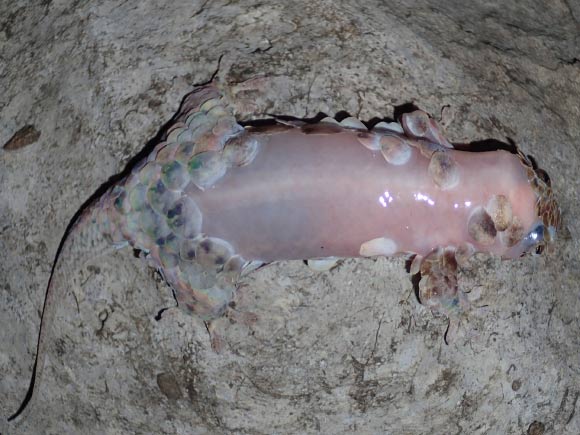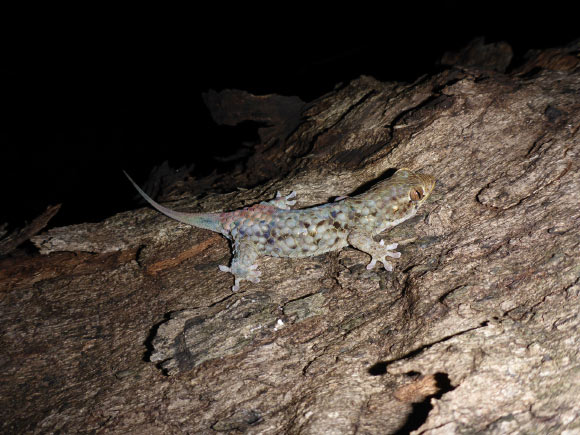A bizarre new species of the fish-scale gecko genus Geckolepis has been found living in the ‘tsingy’ karst formations of northern Madagascar.
The Geckolepis fish-scale geckos are small- to medium sized arboreal and nocturnal lizards endemic to Madagascar and the Comoro Islands.
They have large scales that tear away with ease, leaving them free to escape whilst the predator is left with a mouth full of scales.
The skin of these geckos is specially adapted to tearing. The large scales are attached only by a relatively narrow region that tears with ease, and beneath them they have a pre-formed splitting zone within the skin itself.
Together, these features make them especially good at escaping from predators.
Although several other geckos are able to lose their skin like this if they are grasped really firmly, fish-scale geckos are apparently able to do it actively, and at the slightest touch.
And while others might take a long time to regenerate their scales, fish-scale geckos can grow them back, scar-free, in a matter of weeks.
The new fish-scale gecko species, Geckolepis megalepis, was discovered by Mark Scherz of the Zoologische Staatssammlung München in Germany and his colleagues from the United States, Germany, and Columbia.
“Geckolepis megalepis is the first Geckolepis species to be described in 75 years, and it has been 123 years since the last currently recognized species was described,” the researchers said.

Denuded Geckolepis megalepis; when grasped by a predator, fish-scale geckos lose not just their scales but also the skin underneath; this bizarre behavior is apparently very important in helping them escape. Image credit: Frank Glaw.
Geckolepis megalepis is known from the limestone karst of Ankarana in northern Madagascar.
This species has the largest known body scales of any gecko (both relatively and absolutely), which come off with exceptional ease.
The authors hypothesize that the larger scales tear more easily than smaller scales, because of their greater surface area relative to the attachment area, and larger friction surface.
“What’s really remarkable though is that these scales — which are really dense and may even be bony, and must be quite energetically costly to produce — and the skin beneath them tear away with such ease, and can be regenerated quickly and without a scar,” Scherz said.
By looking at the skeletons of the Geckolepis geckos, Scherz and co-authors were able to identify some features of the skull that distinguish Geckolepis megalepis from all others.
“You have to think a bit outside the box with Geckolepis. They’re a nightmare to identify,” Scherz explained.
“So we turned to micro-computed tomography (micro-CT) to get at their skeletons and search there for identifying features.”
But the scientists also found some surprises: a species named 150 years ago, Geckolepis maculata, was confirmed to be different from the genetic lineage that it had been thought to be.
“This is just typical of Geckolepis. You think you have them sorted out, but then you get a result that turns your hypothesis on its head,” Scherz said.
“We still have no idea what Geckolepis maculata really is — we are just getting more and more certain what it’s not.”
Geckolepis megalepis is described in a paper in the journal PeerJ.
_____
M.D. Scherz et al. 2017. Off the scale: a new species of fish-scale gecko (Squamata: Gekkonidae: Geckolepis) with exceptionally large scales. PeerJ 5: e2955; doi: 10.7717/peerj.2955








